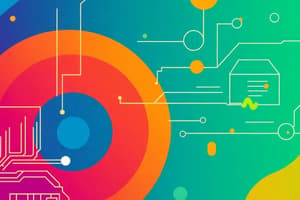Podcast
Questions and Answers
What is the primary capital of knowledge workers?
What is the primary capital of knowledge workers?
- Equipment and tools
- Physical labor
- Knowledge and expertise (correct)
- Financial resources
Which profession is NOT considered a knowledge worker?
Which profession is NOT considered a knowledge worker?
- Architect
- Software engineer
- Construction laborer (correct)
- Pharmacist
What role do expert systems typically play in medicine?
What role do expert systems typically play in medicine?
- They assist in analyzing patient data. (correct)
- They automate the entire healthcare system.
- They function strictly as prescription generators.
- They replace doctors in all decision-making.
Which type of thinking is NOT mentioned as being utilized by knowledge workers?
Which type of thinking is NOT mentioned as being utilized by knowledge workers?
What might an abnormal pattern in a customer's gas bills indicate?
What might an abnormal pattern in a customer's gas bills indicate?
What characterizes data in its raw form?
What characterizes data in its raw form?
Why is it important to manage data properly in organizations?
Why is it important to manage data properly in organizations?
What must occur for data to become information?
What must occur for data to become information?
Which of the following is NOT a use of information in business?
Which of the following is NOT a use of information in business?
How can combinations of data be beneficial to an organization?
How can combinations of data be beneficial to an organization?
What is meant by 'data' in the context of business management?
What is meant by 'data' in the context of business management?
What is a primary function of information in business communication?
What is a primary function of information in business communication?
What role does context play in data processing?
What role does context play in data processing?
What does knowledge enable an individual to do according to the provided content?
What does knowledge enable an individual to do according to the provided content?
What aspect does the DIKAR model emphasize primarily?
What aspect does the DIKAR model emphasize primarily?
In the context of knowledge acquisition, what does 'Action' represent in both the DIKAR and RAKID models?
In the context of knowledge acquisition, what does 'Action' represent in both the DIKAR and RAKID models?
How can the understanding of knowledge be likened to the realization of the object in the box?
How can the understanding of knowledge be likened to the realization of the object in the box?
What role does Information Technology play in the DIKAR model?
What role does Information Technology play in the DIKAR model?
What is the primary focus of the 'Technology' view in the DIKAR model?
What is the primary focus of the 'Technology' view in the DIKAR model?
According to the content, what is primarily required to obtain knowledge according to the RAKID model?
According to the content, what is primarily required to obtain knowledge according to the RAKID model?
What does the phrase 'rate of motion towards knowledge' imply about learning?
What does the phrase 'rate of motion towards knowledge' imply about learning?
What does the 'Junk' accumulating on top of the box metaphorically represent in the context of knowledge?
What does the 'Junk' accumulating on top of the box metaphorically represent in the context of knowledge?
What is defined as explicit knowledge?
What is defined as explicit knowledge?
Which statement best describes the characteristics of explicit knowledge?
Which statement best describes the characteristics of explicit knowledge?
How is explicit knowledge primarily stored and accessed?
How is explicit knowledge primarily stored and accessed?
Which of the following best exemplifies explicit knowledge?
Which of the following best exemplifies explicit knowledge?
What is NOT a characteristic of explicit knowledge?
What is NOT a characteristic of explicit knowledge?
What is tacit knowledge primarily defined as?
What is tacit knowledge primarily defined as?
Which method is primarily used to transfer tacit knowledge?
Which method is primarily used to transfer tacit knowledge?
What makes tacit knowledge difficult to communicate?
What makes tacit knowledge difficult to communicate?
In what way is tacit knowledge different from explicit knowledge?
In what way is tacit knowledge different from explicit knowledge?
What can facilitate the transfer of tacit knowledge between individuals?
What can facilitate the transfer of tacit knowledge between individuals?
Flashcards are hidden until you start studying
Study Notes
Data
- Data is raw, unprocessed, and meaningless on its own.
- Examples include text, numbers, and symbols.
- Data is everywhere, but not always managed effectively within organizations.
Information
- Information is derived from processed data within a specific context.
- It provides meaning and can be used to improve data's usefulness.
- Three main uses of information in business:
- Communication: Sharing ideas, coordinating actions, and informing stakeholders.
- Supporting business processes: Activities or sets of activities to achieve specific goals.
- Decision-Making: Using processed information to make informed choices.
Knowledge
- Knowledge is the understanding of rules needed to interpret information.
- It involves comprehending the relationships between pieces of information and how to apply them.
- Knowledge allows for critical thinking and informed action.
- Examples include using market research data to adjust pricing strategies or analyzing student performance to understand individual needs.
Knowledge Workers
- Knowledge workers specialize in using their knowledge as their primary capital.
- Their work requires a combination of convergent, divergent, and creative thinking.
- Examples include healthcare professionals, engineers, scientists, managers, and academics.
Expert Systems
- Computer programs designed to mimic the expertise of human knowledge workers.
- Utilize probabilities and subject knowledge to provide insights and support.
- Common application in medicine, for instance, analyzing patient data to assist doctors in making diagnoses and treatment plans.
DIKAR Model
- A technological framework that illustrates the progression from data to action and results.
- Emphasizes the importance of each stage and how they build upon each other.
RAKID Model
- A business-focused perspective on the DIKAR Model.
- Highlights the process of obtaining data, defining information, acquiring knowledge, and using it to drive action and achieve results.
Rate of Motion towards Knowledge
- The speed at which we connect with information and its patterns to transform it into knowledge.
- This rate can be influenced by the order in which information is presented.
- Example highlighting the process: Understanding that a series of descriptions refers to a refrigerator.
Key Capital for Knowledge Workers
- Knowledge itself is the primary capital of knowledge workers.
Professions NOT Considered Knowledge Workers
- Manual laborers are typically not considered knowledge workers.
Expert Systems in Medicine
- Expert systems in medicine help doctors diagnose illnesses and recommend treatment plans.
Knowledge Worker Thinking NOT Mentioned
- Although the text discusses various thinking processes of knowledge workers, it does not mention intuitive thinking.
Abnormal Gas Bill Patterns
- Abnormal patterns in a customer's gas bills could indicate potential leaks, appliance malfunctions, or even unusual usage habits.
Data in its Raw Form
- Raw data is characterized by being unorganized, unstructured, and often meaningless without context or processing.
Importance of Data Management
- Proper data management in organizations ensures data accuracy, consistency, and accessibility, enabling better decision-making and strategic planning.
Data Transformation to Information
- Contextualization and interpretation are essential for data to become meaningful information.
Business Uses of Information (NOT)
- Although information serves various purposes in businesses, personal entertainment is not directly considered a business use.
Benefits of Data Combinations
- Combining different data sets (e.g., sales data with customer demographics) can uncover valuable insights and correlations, leading to better business strategies.
Data in Business Management
- Data in business management refers to raw facts and figures collected from various sources.
Information's Primary Function in Business Communication
- Information facilitates effective communication within and outside organizations, allowing for informed decision-making and collaboration.
Context's Role in Data Processing
- Context is crucial for interpreting data accurately and drawing relevant conclusions.
Knowledge's Enabling Power
- Knowledge empowers individuals to apply understanding and make informed decisions in various situations.
DIKAR Model's Focus
- The DIKAR model primarily emphasizes the hierarchy and interconnectedness between data, information, knowledge, action, and results.
'Action' in DIKAR & RAKID Models
- In both models, 'Action' represents the practical application of knowledge, leading to tangible results.
Knowledge Realization Metaphor
- The realization of knowledge is like finding the object hidden in a box. We need to open the box (gather information, apply context) to understand its true nature.
IT's Role in DIKAR
- Information Technology plays a vital role in the DIKAR model by facilitating data processing and dissemination, supporting the flow of information and knowledge.
'Technology' View in DIKAR
- The 'Technology' view in DIKAR primarily focuses on the role of IT tools and systems in enabling knowledge acquisition and utilization.
Requirement to Obtain Knowledge (RAKID)
- The RAKID model suggests active engagement and critical thinking are crucial for gaining knowledge from information and experience.
'Rate of Motion' Toward Knowledge
- The phrase implies learning is a continuous process involving consistent effort and progress towards acquiring knowledge.
'Junk' Metaphor in Knowledge Context
- The 'Junk' accumulating on top of the box represents irrelevant or misleading information that can hinder our understanding and prevent access to meaningful knowledge.
Explicit Knowledge Definition
- Explicit knowledge is knowledge that can be easily articulated, codified, and shared through formal channels.
Explicit Knowledge Characteristics
- Explicit knowledge is objective, easily transferred, commonly documented, and readily available to others.
Explicit Knowledge Storage & Access
- Explicit knowledge is primarily stored and accessed through documents, databases, and manuals.
Explicit Knowledge Example
- A company's employee handbook exemplifies explicit knowledge as it contains codified rules and procedures.
Explicit Knowledge Characteristic (NOT)
- Subjectivity is not a characteristic of explicit knowledge. Explicit knowledge is objective and factual.
Tacit Knowledge
- Tacit knowledge is intuitive knowledge and expertise acquired through experience, practice, and values.
- It is deeply rooted in context and is difficult to articulate or communicate explicitly.
- Resides within the mind of the individual.
- Transferred through social interactions, mentoring, and observational learning.
Studying That Suits You
Use AI to generate personalized quizzes and flashcards to suit your learning preferences.




